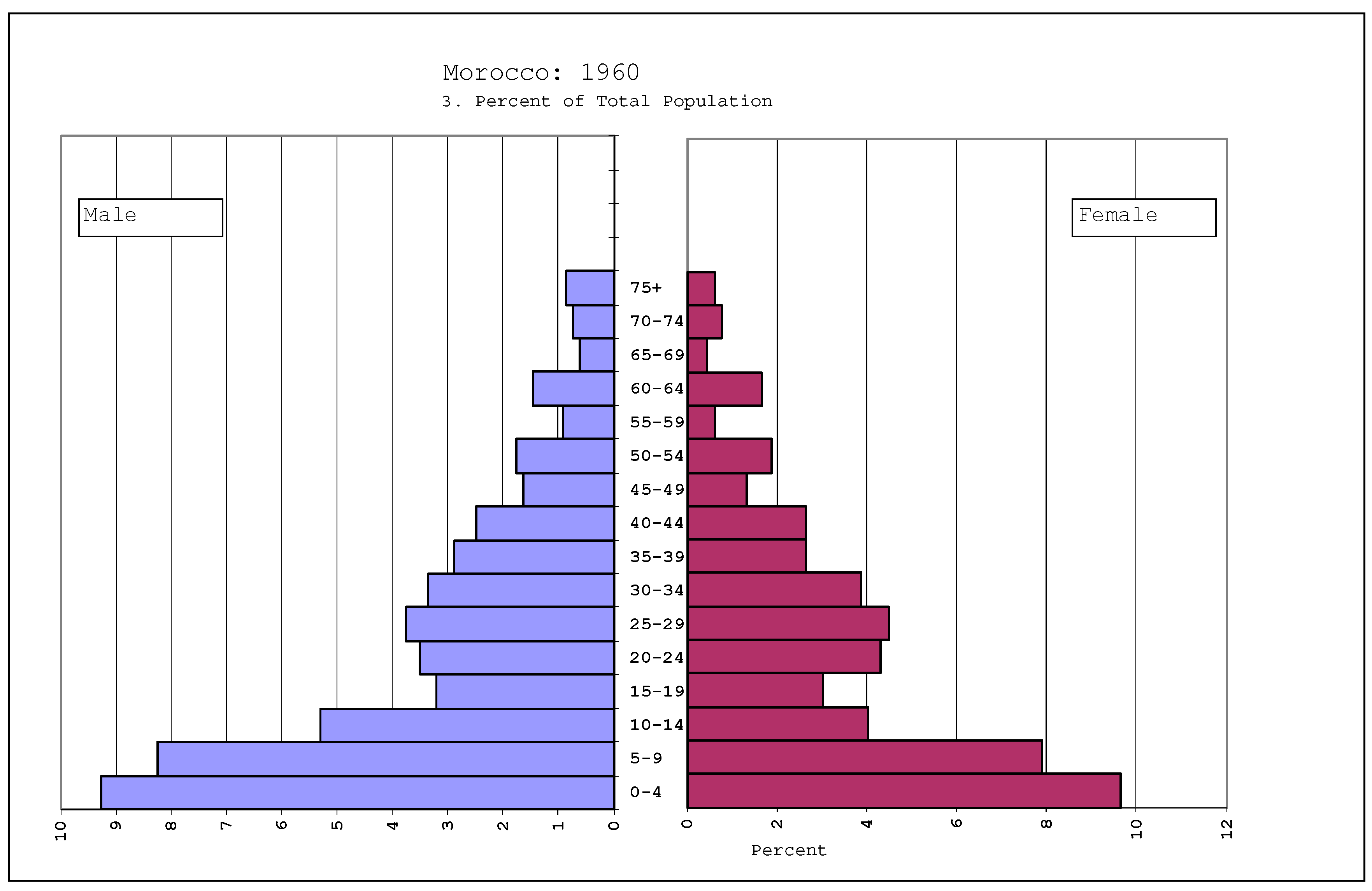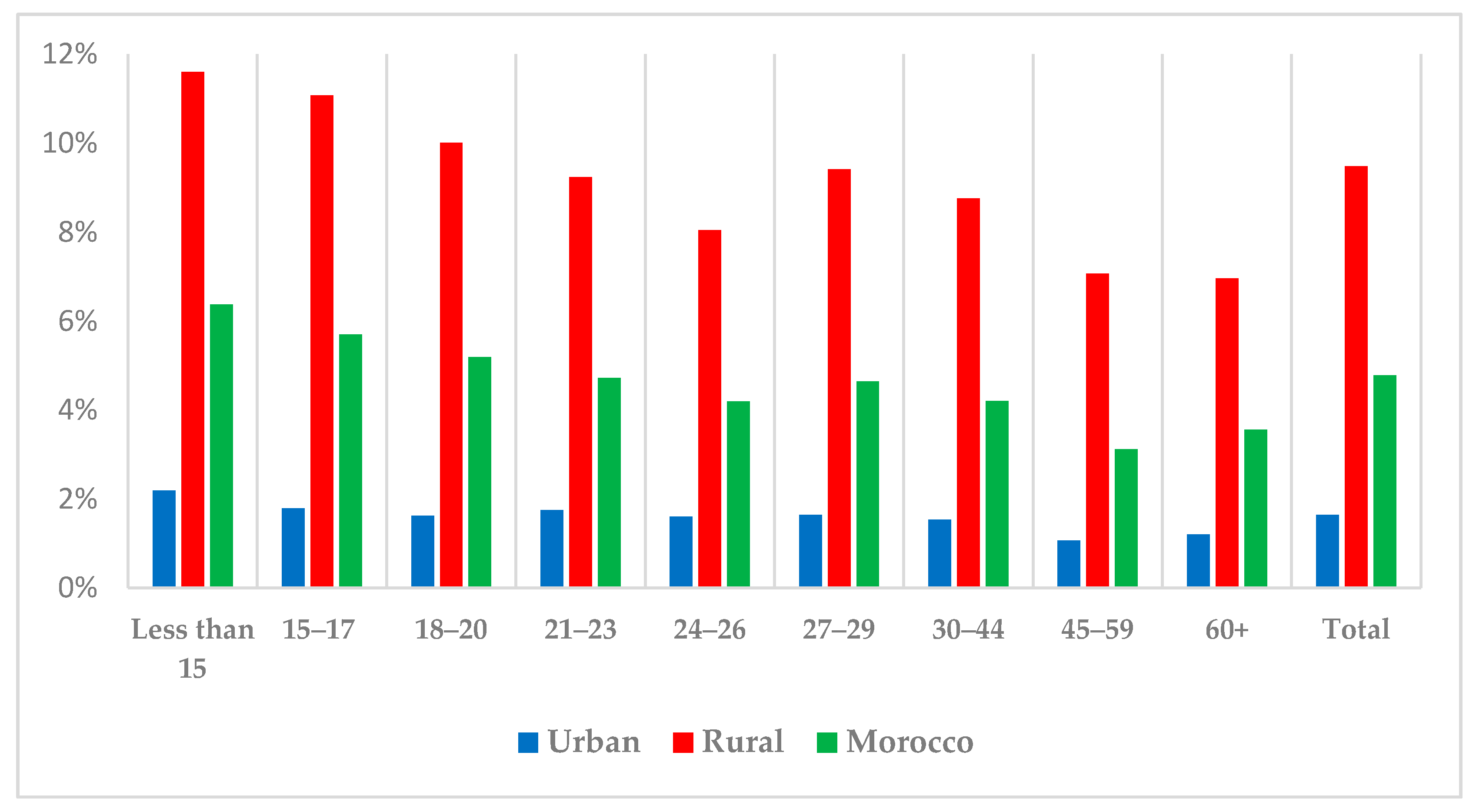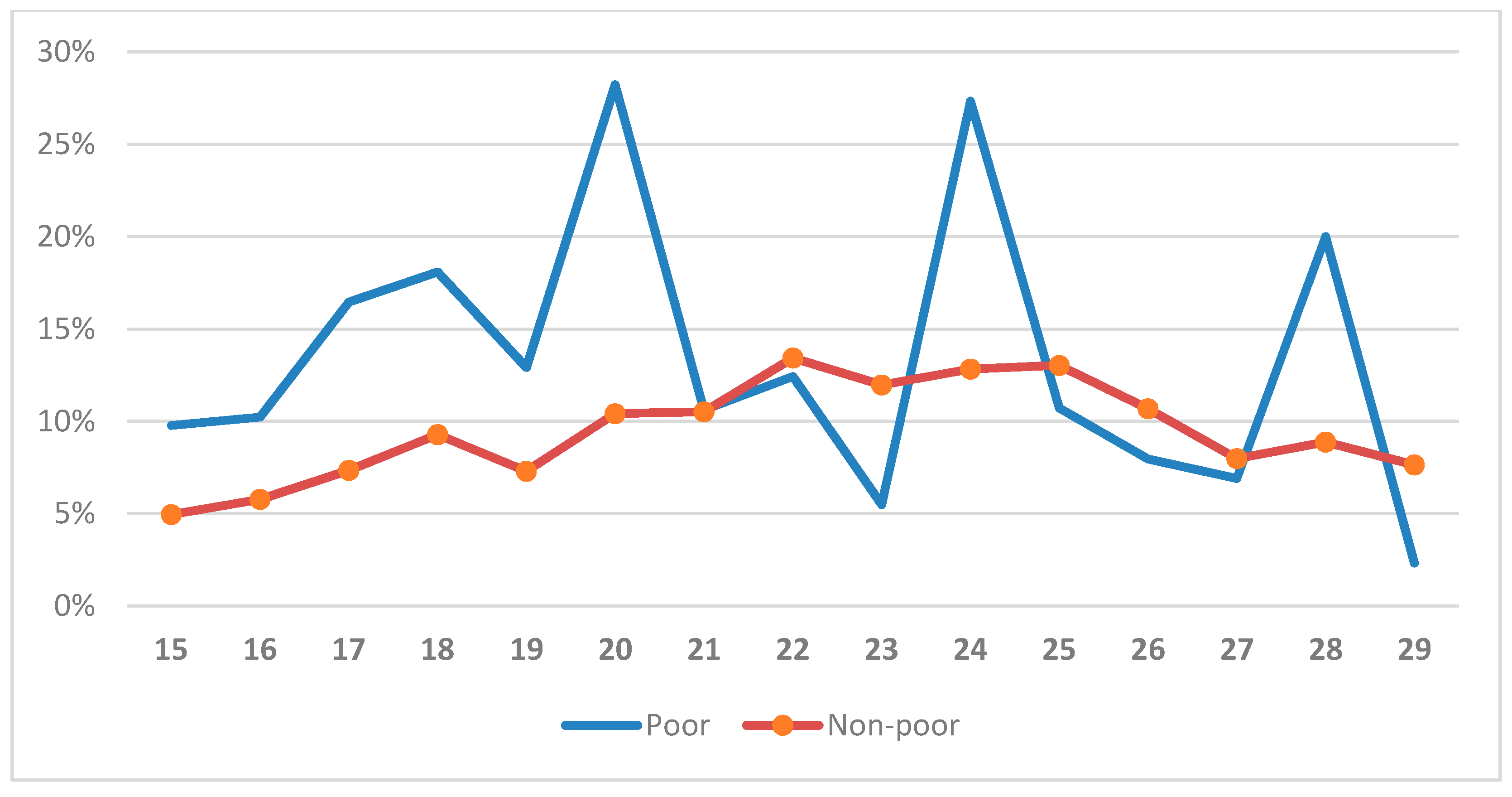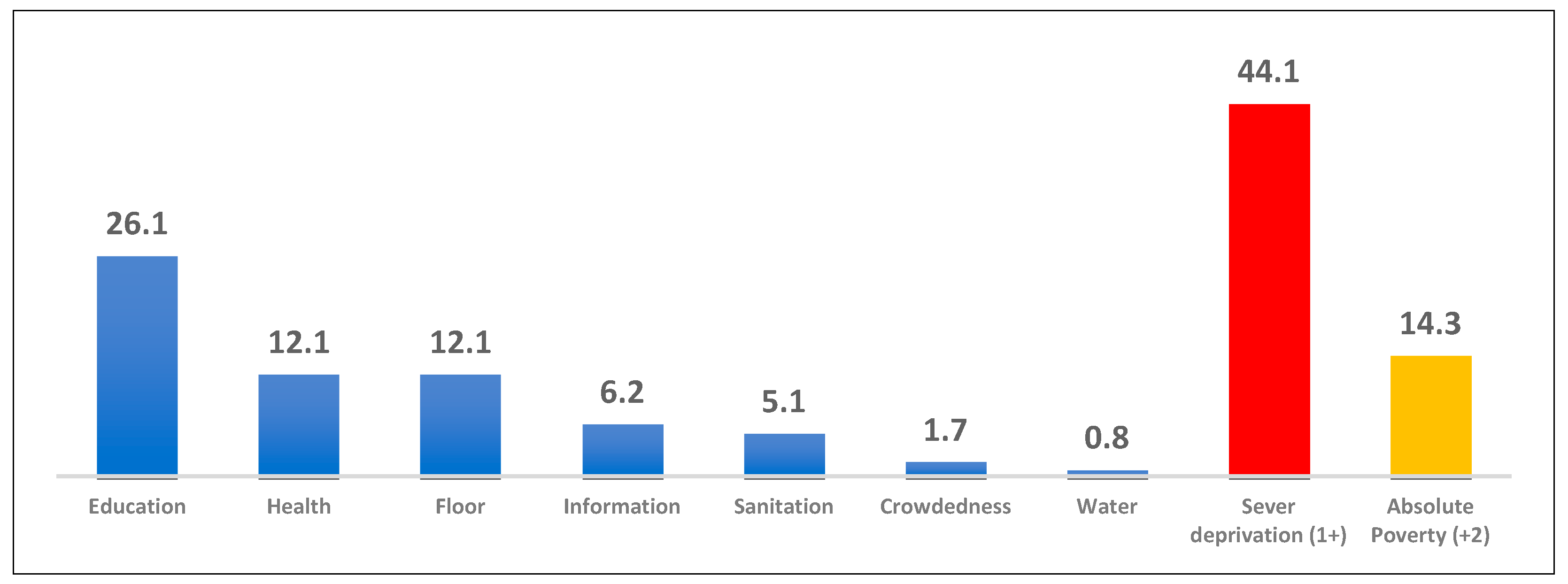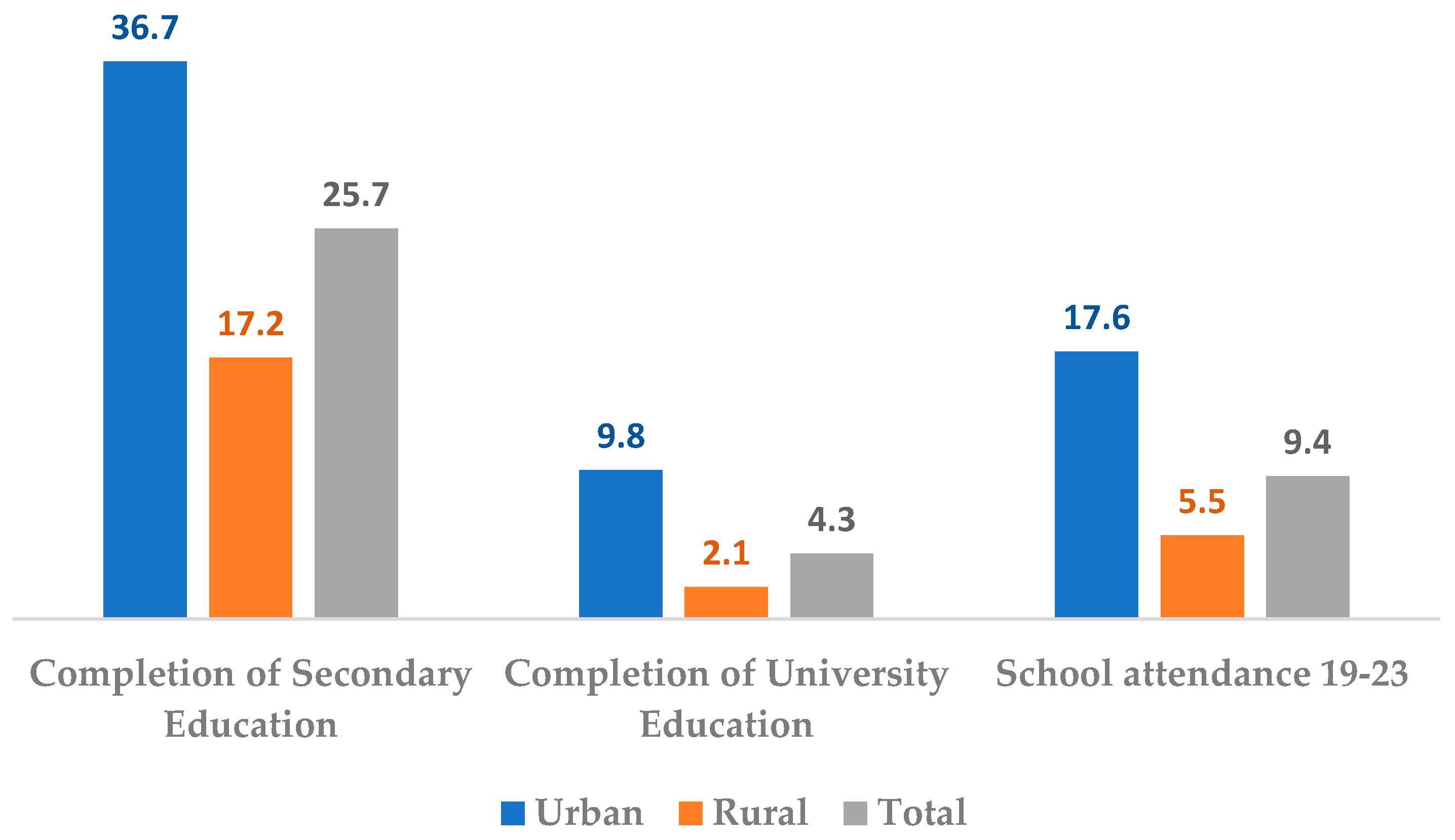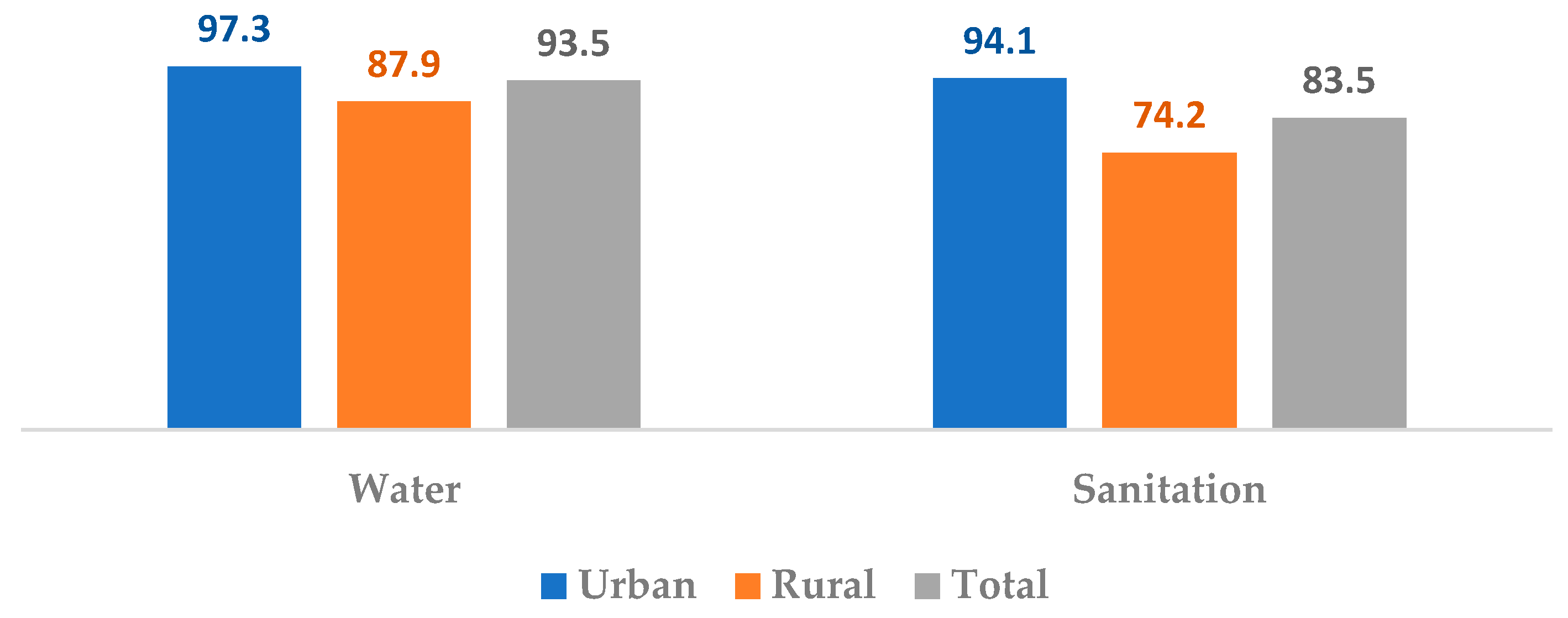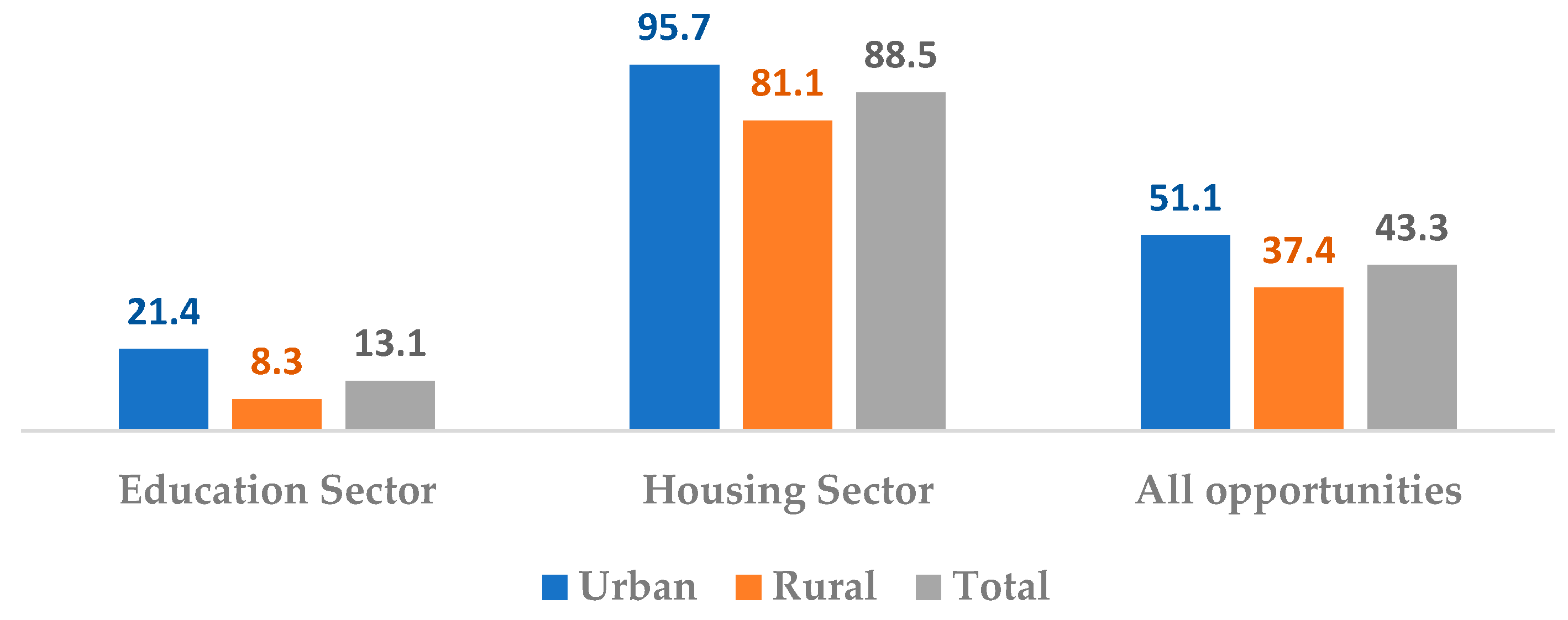3.2.1. Youth Poverty Measurement
While it is widely recognized that living standards are determined by a multitude of factors, monetary measures like relative and absolute poverty remain popular. Relative poverty, which reflects a more income-distribution-oriented design, is the common approach used in Western Europe and at the (non-US) OECD and the most developed countries (
Ravallion 2012). The poverty line is set at a constant proportion (typically around half) of a given distribution of income (the current mean, median, or some quintiles) and anyone whose income is below this threshold is considered poor (
Förster and D’Ercole 2012). Unlike developed countries which are using income to measure poverty according to a monetary approach, consumption—or expenditure data—directly collected from households as a proxy of income are mostly used in developing countries, as expenditure is easier to track than income (
Ravallion 2010;
Sahn and Stifel 2003).
Recently, there has been a revival of interest in multidimensional and subjective well-being, although relative and absolute monetary approaches can still dominate poverty measurement (
Ravallion 2012). Particularly, the multidimensional approach is now broadly recognized as important and complement to monetary poverty. To this end, the Multidimensional Poverty Index (MPI) developed at Oxford University with the UNDP’s Human Development Report Office uses 10 indicators to measure three critical dimensions of poverty at the individual level: education, health, and material living standards. The methodology underlying the MPI is based on
Alkire and Foster (
2011) and offers a high degree of flexibility in the choice of indicators.
In developing countries, as the case in Morocco, most surveys do not collect data on the income of households because this can be time- and money-consuming (
Vyas and Kumaranayake 2006). Moreover, sampling bias, under-reporting of income or expenditure, and difficulties in converting household products into money terms are also raised. In addition, it is impossible to calculate poverty without considering regular (stable) incomes that come from unformal jobs (one reviewer). For these reasons, an alternative tool for classifying the households in their socio-economic status was proposed for low- and middle-income countries. This method is an asset-based approach which allows to construct a household-level composite index called Wealth Index. The indicator is calculated using easy-to-collect data on ownership of durable assets, housing characteristics, and access to services (
Filmer and Pritchett 2001). Data on these items are already collected in large-scale surveys and Population Census.
According to our available data, the poverty measurements in this paper include both economic measures of poverty based on monetary measures, and non-monetary measures reflecting multidimensional privation status in the health, the education, and the personal development of youth. These two approaches of defining poverty are conceived as complementary approaches rather than different approaches (
Alkire 2007).
Youth living in poverty are subject to multiple deprivations in many of their rights: to survive, to learn, to work, to participate, and to be protected. The UNICEF child poverty approach (
UNICEF 2011) is used to operationalize this rights-based approach to youth poverty. This paper uses a series of indicators to measure youth’s access to seven rights (education, health, safe drinking water, sanitation facilities, crowdedness, information, and floor).
Table 1 shows the dimensions and indicators employed in this paper. While severe deprivation refers to youth who do not have access to one or more of this rights, absolute poverty refers to youth who do not have access to two or more of these rights.
Multidimensional poverty includes the multiple factors that constitute poor youth’s experience of deprivations, namely, safe drinking water, sanitation facilities, crowdedness, improper flooring, education, health, and source of knowledge. The Bristol approach developed by
Gordon (
2006) and adopted by the Global Study (
UNICEF 2007) makes a significant effort to provide a methodology for measuring multidimensional child poverty. The Bristol approach defines two different cross-dimensional cutoff points to identify multidimensional poverty, namely, youth in severe deprivation and youth in absolute poverty as defined previously. Accordingly, the prevalence of the multidimensional poverty among youth is calculated (the Headcount Ratio), where youth who experienced at least one dimension of deprivation are considered multidimensional poor.
Regarding monetary poverty in Morocco, the poverty line is constructed using the methodology of the cost of basic needs (
Ravallion and Bidani 1994). A food bundle is constructed such that it is consistent with the consumption of poor households and reaches calorie requirements. The cost of these food bundles is then established. This is known as the Food Poverty Line (FPL). Households whose expenditure is below the FPL are considered extremely poor. A second poverty line is constructed by adjusting the FPL with an allowance for expenditure on essential non-food goods. This results in what is called the Total Poverty Line (TPL). Households spending less than the TPL are considered poor. In 2013–2014, on average, a person who spent less than (388 MAD in urban area, 359 MAD in rural area) per month was poor. Youth living in households whose consumption is below TPL are considered as poor.
3.2.2. The Human Opportunity Index
The Human Opportunity Index developed by
Paes de Barros et al. (
2009) and
Molinas (
2012) measures the extent to which a society progresses toward universal access of basic opportunities. The index synthesizes in a single indicator how close a society is to universal coverage of a given opportunity and how equitably coverage of that opportunity is distributed.
The HOI is a measure of access to, or coverage of, essential services for youth development, discounted or penalized by the inequality of access across the potential beneficiaries. Therefore, the HOI improves either by increasing access to services and/or by making access more equitable (
World Bank 2012b). The HOI is used to measure the access of youths to essential services, penalized by the inequality of access across the place of residence.
where C is the rate of global coverage, which is the percentage of individuals that have access to the opportunity, and P is associated with inequality of opportunities,
D is the dissimilarity index, which measures the difference between the rates of coverage of an opportunity across different groups of circumstances. The D index is commonly used to assess inequality in a binary outcome (
Paes de Barros et al. 2009). The dissimilarity index is derived by comparing group means for different combinations of circumstances to the population mean to quantify how outcomes differ by circumstances. It can be interpreted as the share of the total number of opportunities (that is, places available in a service) that needs to be reallocated between circumstance groups to ensure equality of opportunities (i.e., that is redistributed from the young in wealthier groups to the young in the worst groups, which means the missing level of opportunities to have equal chance of an outcome across groups). Thus, the D index range from 0 to 100, with 0 indicating a situation of equal chances and 100 refering to total chance inequality across circumstances.
Thus, the HOI range is from 1 to 100, and it increases with the global rate of coverage and decreases with the differences in coverage between the different groups of circumstances,
where (1 − D) represents the percentage of opportunities available that are assigned correctly.
Computing the penalization for inequality of opportunities, P, requires the identification of all groups of circumstances with rates of coverage below the average. We refer to these as the groups vulnerable to human opportunity. For each group vulnerable to opportunity, i
is the number of people who have access to a necessary good or service, so that their rate of coverage is the same as the average, while O is the number of people in group i with access.
is thus the difference in opportunities within the vulnerable group i. The penalization is the sum of the differences in opportunities of all the vulnerable groups divided by the total population N:
Intuitively, P can be interpreted as the percentage of people whose access would have to be reassigned to people in groups with lower rates of coverage to reach equality of opportunities. If all the groups have the same rate of coverage, then the penalization is zero, and no reassignment would be necessary. As long as the coverage approaches universality for all groups, the reassignment required will be close to zero (
Paes de Barros et al. 2009).
The global coverage, C, is calculated using the Logistic Regression Technique utilizing all the related circumstances (for example, gender of the youth, education, gender of the head of the household, and the like) to assess the impact of these circumstances on each opportunity (for example, access to clean water) and to calculate the average (C) using the predicted probabilities. Let P denote the probability that youth have access to a certain service:
where
The dependent variable Y is the access to a certain service, the vector of explanatory variable X is the related circumstances, and βjs are the corresponding parameters. Accordingly, C is the average of these estimated probabilities along all populations.
The HOI has important properties. Its value decreases as the inequality of a given number of opportunities increases. If no one loses access and at least someone gains access, the index will always increase, whether or not that person belongs to a vulnerable group. Finally, when the coverage rate of all circumstance groups increases proportionally, the HOI will increase proportionally.
When analyzing cross-sectional household survey data, the procedure consists of running a logistic regression model to estimate at an individual level the relationship between the access to a particular opportunity (binary dependent variable) and the circumstances of an individual (independent variables), on the full sample for which the HOI measure will be constructed. The estimated coefficients of the regression are used to obtain for each individual his/her predicted probability of access to the opportunity, which is then used to estimate the D-index, the coverage rate, and the HOI.
3.2.4. Circumstances
The specific factors we examine in this analysis are the household size, the household head’s education, the gender of the head of the household, the area of residence (urban or rural), and the household wealth. All these factors can be calculated for the survey that we have used.
Household size is the number of persons living as an economic unit. A household head’s education is defined as the highest level of education attained by the household’s head. The gender of the head of the household distinguishes between male and female. Area of residence distinguishes between urban and rural residents. Lastly, we considered household wealth, which is defined based on factor analysis using indicator variables to determine whether the household owns certain assets and goods such as the internet, a television, or a car. Then, wealth quintiles as measured by
Yassine and Bakass (
2022) are used for the classification of households from the poorest to the richest.
3.2.5. Regression Analyses
The HOI is a composite index of two factors: the level or coverage and equity of opportunity. The policymakers’ objective will be to maximize HOI, which can be achieved either by enhancing total opportunity (coverage) or by increasing equity of opportunity (more equitably distributing opportunity) or increasing both coverage and equity. The index allows the measurement of the total contribution of all circumstance variables to the inequality of opportunity. Although it is useful to determine the total impact of all circumstance variables on the inequality of opportunity, determining the impact of individual circumstance variables would be more useful to policymakers (one reviewer). These individual contributions will identify the circumstance variables having the most impact on inequality of opportunity.
To calculate the relative contributions of individual circumstance variables to the inequality of opportunity, we use regression analyses to estimate how a particular circumstance is related to an outcome while considering other characteristics such as household wealth. Since all the outcomes are binary (0 (no) or 1 (yes)), we use a logit model to estimate the effects of circumstances on the youth outcomes. The logit model given by
where
p denote the probability that the youth is not deprived; and
are the predictor variables. In applying the logit model in this paper, a value of 1 was assigned to youth having access to the opportunities, and a value of 0 on the contrary.
In addition, we use a logit model to identify the determinants of youth income poverty. A value of 1 was assigned to poor youth, and a value of 0 on the contrary.
